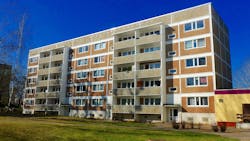By David Sumi / Airvine
Like apartment buildings and other MDUs, another type of MDU needs to boost broadband connectivity. In this setting, systems cannot be disconnected during the upgrade project. Here, we are discussing assisted living centers and similar facilities for seniors.
Senior citizen assisted living centers are experiencing a growing need for upgraded broadband connectivity to meet the diverse requirements of their residents and the facilities supporting them. Telehealth services, streaming entertainment, video calls with relatives, and the proliferation of IoT devices necessitate a seamless and reliable network infrastructure.
Furthermore, many of these IoT devices are health monitoring-related and cannot be turned off. Medical IoT is, therefore, a genuinely mission-critical requirement and needs “carrier grade” reliability with as close to zero downtime as possible – a good reference point is the long-standing telephone company standard of “five 9s” of network uptime (meaning only 6 minutes of downtime the entire year). Other requirements to consider when deciding upon an internal backbone type of network to connect all rooms and devices are:
The needs of residents in wheelchairs and other mobility-impaired situations and who are essentially confined to the facility. This project must be completed without workers “getting in the way” of residents and facility staff. There needs to be no hindrance to the accessibility of staff reaching residents in an emergency and the mobility of residents cannot be restricted during the installation of a new broadband connectivity system.
Reducing costs
It saves money with a budget that would be less expensive than using Ethernet cables and other wiring for this project. Many of these accommodations are on restricted or very tight budgets, with Medicare as the primary source of funds for residents.
The desirability of having an improved Wi-Fi network throughout the facility, with the latest Wi-Fi 6 access points for staff, residents, and visitors to support the high bandwidth and low latency requirements of the applications on the network.
Fortunately, due to advances in wireless systems operating in the 60 GHz band, there is a way to meet all these requirements with minimal disruption to the facility’s operations or the residents’ lives. Using 60GHz indoors matches the inherent short range of these systems to an environment that is also short range. There are no requirements indoors for a 1-mile link. It’s rare to have a link exceeding 100m and usually ranges from 25 to 50m. However, the Line of Sight (LoS) restriction still exists – or existed – as it is now possible to penetrate interior walls and beam steer over 90 degrees to go around corners.
New beamforming and system gain capabilities have changed the calculus of using 60GHz and created a market for indoor cable extension and replacement. With the 14GHz of available spectrum, it is now possible to realize capacities of 10 to 20Gbps Full Duplex. Furthermore, the 60GHz band offers virtually interference-free transmissions, ensuring continuous and uninterrupted connectivity.
Avoiding disruption
Running CAT-5 Ethernet and other cabling can be very disruptive and time-consuming and can affect the accessibility and mobility considerations of residents. Construction in the hallways is either not allowed or must be done off hours. Ensuring the safety and mobility of residents during the broadband upgrade is paramount. Installing wireless nodes, such as Airvine’s WaveTunnel system, offers several advantages in this regard, such as:
· Non-Intrusive Installation: these wireless nodes can be mounted on the ceiling or other high points and strategically deployed without extensive wiring or invasive construction. This minimizes disruption to residents and staff, ensuring their unimpeded movement within the facility.
· Compact Design: The system's compact form factor (about the size of a current model X-Box) and discreet installation enable it to blend seamlessly into the environment, eliminating any hindrance to accessibility.
· Emergency Access: The installation plan should include clear pathways for emergency access.
Furthermore, the reliability of the 60 GHz Spectrum Band is well known. Unlike the noisy lower bands, there are no sources of interference in 60 GHz, which can ensure continuous and uninterrupted connectivity. This is of utmost importance for IoT health monitoring devices. With interference-free spectrum, residents' health monitoring devices can operate 24/7 without any interruptions. This guarantees the continuous collection and transmission of vital health data, ensuring residents' well-being. In addition, these wireless nodes can be configured with redundancy, providing a failover mechanism to enhance reliability further. In the event of an issue with one node, traffic seamlessly shifts to another, maintaining constant connectivity.
A wireless node system offers significant cost savings compared to traditional Ethernet cables and wiring solutions. The associated conduit and labor costs reduce the project budget by eliminating the need for extensive cabling. Each node can typically be installed in less than 30 minutes with only essential tools and a smartphone configuration app. Regarding “OpEx” and maintenance, the system's reliability, and longevity result in lower maintenance expenses over time, further contributing to cost savings.
Improving Wi-Fi
The deployment of a gigabit-speed wireless backbone will also result in an improved Wi-Fi network, especially when it concerns the new Wi-Fi 6 and the coming Wi-Fi 7 access points. For many residents, Netflix and other streaming applications are vital sources of entertainment. Airvine's wireless nodes support the latest Wi-Fi 6 standard, ensuring faster speeds, increased capacity, and improved performance for staff, residents, and visitors. Deploying wireless nodes across the property guarantees seamless and comprehensive Wi-Fi coverage throughout the facility, reducing dead zones and providing a better internet experience for all users.
For seniors and those caring for them, maintaining continuous network connectivity for IoT medical monitoring devices and entertainment services in senior living centers is essential for residents' health, safety, and well-being. Comprehensive and affordable network coverage empowers caregivers, enhances residents' quality of life, and provides a robust infrastructure for monitoring, response, and data-driven healthcare improvements.
However, many of these facilities were constructed with CAT5 (100Mbps) cabling and have struggled to afford much-needed network upgrades. “Fall” buttons, heart monitoring and wellness assurances are standard offerings, but need the network to support them – especially when factoring in that streaming video in 4K overwhelms legacy cabled infrastructure.
The advent of 60 GHz wireless offers a comprehensive and efficient solution for delivering gigabits of capacity to upgrade broadband connectivity in senior living centers. It addresses accessibility concerns, ensures the reliability of IoT health monitoring devices, offers cost savings, and provides an improved Wi-Fi network for all users.
David Sumi is the VP of Marketing and PLM for Airvine.





